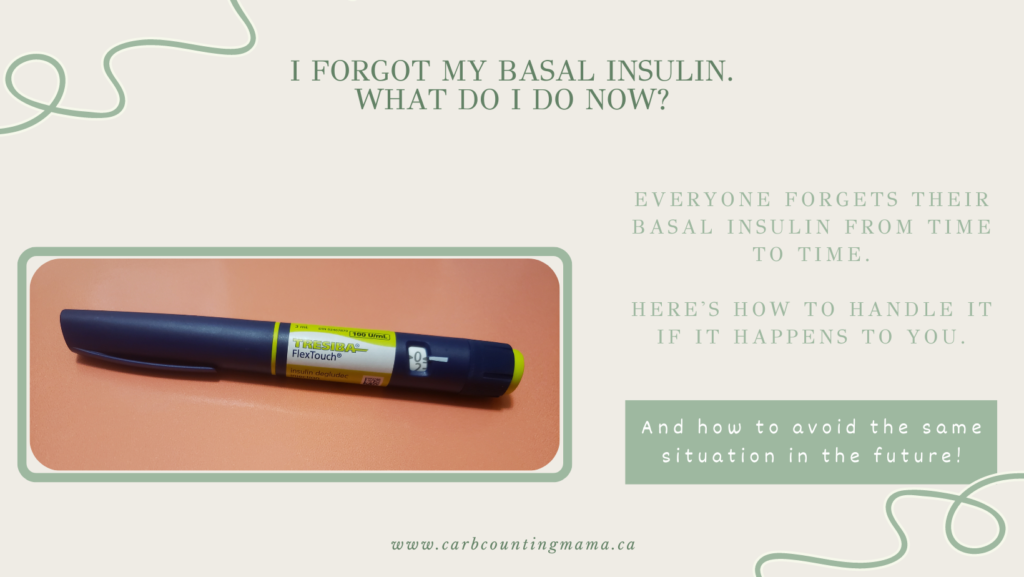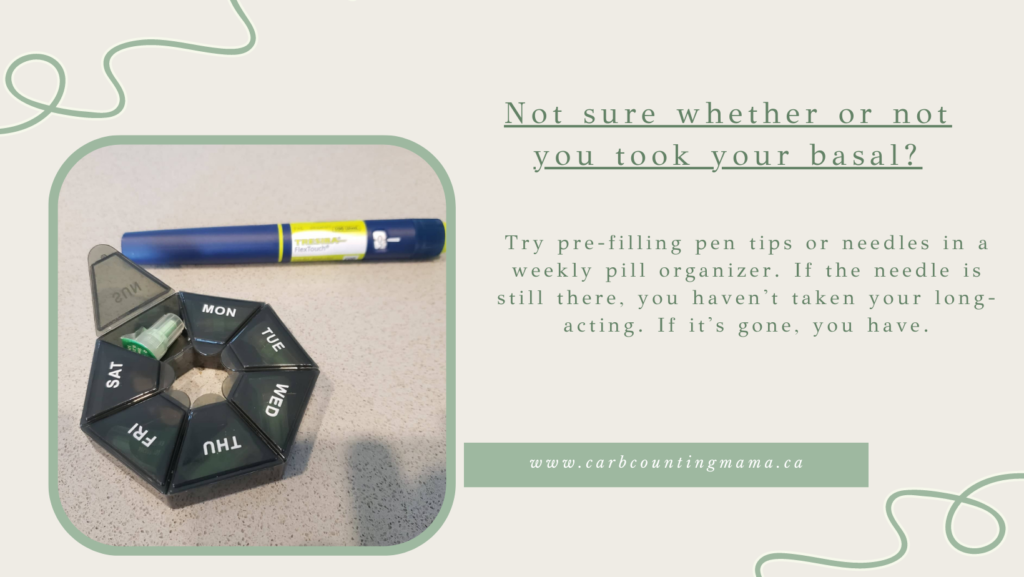You’re having a great day. You’ve accomplished everything on your “to-do” list. The kids are content, the pets are taken care of, and the chores are done. You’re patting yourself on the back for the wonderful job you’ve done today. But you have a little nagging feeling in the back of your mind. Suddenly, it hits you. You forgot to do your basal insulin!

This post contains affiliate links
I am not a doctor or medical professional. This article is for informational purposes only. If you are thinking about changing the way you treat your diabetes, consult your medical team for assistance.
Ok, ok. More likely, your day was super chaotic like every other day and your basal insulin was just one of several balls that were dropped today.
Don’t worry. Everyone has days like this and everyone with T1D forgets their basal insulin from time to time.
Now that you’ve realized what happened, the question is, what should you do about it?
What happened?
First, it’s very important that you’re sure you forgot your basal dose. Giving basal is a mundane task, it doesn’t take long for us to start doing it on autopilot. That means, sometimes, we might have a hard time remembering whether or not we did it.
This can result in accidentally doubling basal or missing it completely. You certainly don’t want to go from thinking you’ve missed it to inadvertently giving double your dose, so make sure it was missed before doing anything.
The good news is that missing a dose of basal is not likely to cause an emergency. There can be negative effects, which we’ll talk about in a moment, but chances are pretty small that this will turn into any sort of critical situation.
If you’re sure you forgot your basal insulin
This is the part where I reiterate that I’m in no way a medical professional. I am, however, someone who has dealt with this before. And I understand basal insulin, how it works, and what happens if it’s missed. So, we can look at this logically and work through some possible solutions.
What’s going to happen?
Well, lack of insulin can cause two things. High blood glucose numbers and ketones. If it’s bad enough and left untreated for too long, that can lead to DKA. But we’re going to sort this out before it gets to that point.
Let’s start troubleshooting.
The first thing to consider… how long has it been since you were supposed to get the dose?
If it’s been under 2 hours since the time you were supposed to take it, you can just take it as you normally would and carry on. If you use an ultra-long-acting insulin, like Tresiba, you can give your dose up to 8 hours after you were supposed to and your bg should still be fine.
Is that the case for you? If so, take your basal dose now and take the next one at the usual time. Easy. You’re done.
But sometimes, we don’t notice right away. It might be several hours later. Maybe you only noticed when you started seeing high bg readings that didn’t make sense. Maybe you were supposed to take it before bed but you didn’t realize it had been missed until morning.
If you noticed outside of your basal insulin’s window, there’s a bit more to it.
What should we do now?
It’s always a good idea to contact your diabetes team. They’ll be able to figure out a plan with you. Even if you come up with a solution yourself, it’s smart to keep them in the loop.
For now, here’s the problem on the most basic level: your body needs a certain amount of insulin and it currently doesn’t have enough.
So, we need to check for ketones, bring bg back into range if it’s high, and replace the missed insulin. But we have to be careful how we do those things.
Ketones
One of the things that should be done when we realize basal insulin has been missed, is to check for ketones. Yes, even if bg is in range.
Lack of insulin is the cause of DKA. If you’ve missed your basal dose, you might be heading in that direction. It’s important to confirm whether or not you’ve developed ketones and to get them cleared if you have. You should have instructions about how to dose for ketones from your doctor. Ketones generally need insulin to get them out of your system. If you don’t have instructions about ketones, you should contact your doctor to get some.
It’s best to check for ketones with a blood ketone meter. The Freestyle Libre Reader works as a blood ketone meter if you don’t have one. Even if you don’t use the Libre CGM system, you can use the reader for checking ketones.
Bring bg back into range
If your bg is high, regardless of how you’re dealing with the missed dose of basal, you’ll need to give a correction.
You’re probably going to need more than your usual correction factor. Remember, you’re bolusing for the high bg, missed basal insulin, and ketones if you have them. This can get complicated, so if you’re not sure how much to bolus, discuss it with your diabetes team and refer to their instructions.
Keep hydrated
Especially if you have high bg and/ or ketones, make sure you stay hydrated. Water or zero-sugar sports drinks work well.
Dehydration can make ketones and high bg worse, leading to DKA. Keeping your body hydrated will help flush the ketones and built-up glucose out of your system, with the help of insulin of course.
Replacing the missed basal insulin
You still need to address the lack of insulin. It basically boils down to two options:
- Give the missed basal insulin.
- Make up for the missed basal insulin with bolus insulin every few hours.
I mean honestly, what else could we possibly do? Those are the options, basal or bolus. But, it’s often not as simple as just doing one of those things. There’s a little more to it.
Giving basal insulin when you notice it was missed
So, you forgot the basal dose that you were supposed to get 10 hours ago?
In theory, you could just give the dose when you realize your error. Pretty simple… or is it?
If it’s been several hours since you were supposed to get your basal, your bg is probably starting to go high or has been on the higher side for several hours. And this new dose of long-acting isn’t going to start working for 4-6 hours. You’ll probably need to bolus with your rapid insulin to take care of the high glucose level. It needs to make up for some of the missed basal and possibly ketones. We already talked about how that might be tricky to calculate.
Here’s the other issue:
When you change your basal time, you can’t just change it back with no negative effects.
Let’s say you usually give your basal at 7 pm, but this time, you forgot until 9 am. You can’t give your full basal dose at 9 am and give your regular basal dose again at 7 pm that evening. Those doses will overlap, essentially doubling your basal for several hours, which is likely to cause lows.
That leaves you with 2 options.
Either stick with the new basal time or gradually move it back to the original time over several days.
If the new time works for you, that’s definitely the simplest option.
But if it doesn’t, you can’t just go from 9 am one day to 7 pm the next.
When moving basal insulin times, most people move it only 1-2 hours each time. There’s still a bit of overlap or a couple of hours with less coverage (depending on the direction you’re moving the time), but it leaves you with an even basal the majority of the time.
An example of giving the missed dose at 9 am but wanting to switch it back to 7 pm, might look like this:

As you can see, it can take a week or more to move your basal time back to where it was. And you might even want to be more conservative only moving it an hour each day. It can be a lot of extra effort. If you’re going to do this, I strongly suggest setting alarms on your phone to remind you of the different dose times each day.
Alternatively, some doctors will recommend giving a partial dose of your basal and then immediately going back to your regular routine. For instance, in the example above, you might give approximately half of your basal dose at 9 am since you only have half the time left, and then you’d give your normal dose at 7 pm.
While this seems logical on the surface, it doesn’t make much sense when you think about it. You’re still not getting enough insulin during those hours (between 9 am and 7 pm in the example). And the insulin duration hasn’t changed, so this partial dose is still going to overlap with your next dose.
Using bolus insulin to make up for the missed basal insulin
Theoretically, you can use rapid insulin until your next basal dose. There are a couple of downsides to this option though.
Since the duration of most rapid-acting insulins is approximately 3-4 hours, giving boluses instead of basal means lots of extra pokes. Every few hours, you’d need to give a bolus.
The bigger issue is that rapid insulin isn’t necessarily a 1:1 ratio to your basal. It might be difficult to figure out how much you need to bolus to replace the missed basal. Really, you’re kind of chasing highs with this method.
So, basal or bolus?
Usually, the deciding factor is how long you have to wait until the next scheduled basal dose.
If it’s not long until your next dose, it might be worth just doing a bolus or two to tide you over.
But if your next dose is quite a ways off, using basal insulin is probably the best option.
Basal insulin is called “long-acting” for a reason. If you’ve noticed that it’s been missed, or if you’ve accidentally doubled it, you have some time to assess the situation and figure out how to move forward.
And if you’re not sure what the best option is for you, your diabetes team is just a quick phone call or email away.
~ Leah
Have you ever forgotten your basal insulin? What did you do to fix the error?
For more tips and stories about T1D, join the Carb Counting Mama email list, and make sure to head over to the Carb Counting Mama Facebook page and “like” it.
To avoid this situation in the future, try pre-filling pen tips or needles in a weekly pill organizer. Trust me, it’s a lifesaver!

Leave a Reply